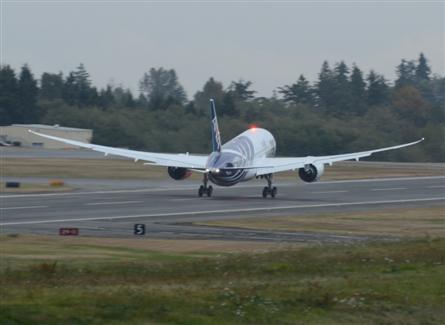The Boeing 787 should have been in service for more than three years, but after a series of frustrating delays it is only just making its debut with launch customer All Nippon Airways. Now we will finally get to see if the Dreamliner can walk the talk
For Boeing, All Nippon Airways and the 787 Dreamliner, it's time for the talking to finally stop and the action to start. Arguably the most revolutionary airliner for a generation is now pulling up at boarding gates and finally beginning to earn money for the first of its "early adopters".
ANA's first 787 was due to take off from Tokyo on its maiden revenue flight on 26 October - a four-hour charter flight to Hong Kong. From 1 November, ANA's Dreamliner business begins in earnest, with Boeing's carbonfibre wonder jet starting a work-up on its domestic network. And from January, it will be operating its first long-haul route on ANA's new Tokyo-Frankfurt service in a spacious 158-seat layout.
 |
|---|
It has been a long, hard and frustrating slog from that first 787 order signed by ANA in 2004, through the momentous - and somewhat deceptive - roll-out on 8 July 2007, and then three years of countless delays to the first delivery on 26 September and its service debut in October.
There must have been times when Seattle - and ANA - wondered if the dream would ever be a reality. However, as ANA's chief executive Shinichiro Ito put it in our August cover interview: "A more difficult delivery can only make the baby more precious and adorable."
As the 787 lurched from crisis to crisis, even Airbus - which admits to having been caught off-guard by the 787's early sales success - must have started to think it needn't have been so worried when the 787 first burst on to the scene. But now, with 787 deliveries finally under way, the spotlight swings on to Airbus as it strives to avoid similar dramas transitioning the A350 from the drawing board to reality.
To mark the Dreamliner's debut, Flightglobal has produced a special report (published with this month's Airline Business) which examines the trials and tribulations the programme has endured during the past seven years, as well as how the new jet promises to revolutionise airline networks.
Ever since the concept of a "super-efficient airliner" was unveiled by Boeing in 2002 in a clever smoke-and-mirrors effort to divert the public's gaze from its Sonic Cruiser U-turn, Seattle has talked up the opportunities that such an aircraft could offer airlines.
Boeing's message has been that the Dreamliner will drive its "network fragmentation" vision, with its ability to connect city pairs that did not have the volume of demand to justify regular services. "Fragmentation really gives passengers more of what they want, and that's more frequent non-stop service," says Boeing's marketing boss Randy Tinseth. "What the 787 does is take that to an all-new level."
And while the Airbus A380 has grabbed the headlines and assumed the role of fleet flagship, the reality is that four years after deliveries began there are still fewer than 60 of the giants in service. Therefore, its much-trumpeted game-changing credentials are yet to be fully established.
However, if Boeing can get its ramp-up act together, then the 787 fleet should quickly gain a critical mass across the globe with the world's airlines, giving it the opportunity to prove its worth.
Akbar Al Baker, chief executive of another early 787 customer Qatar Airways, certainly can't wait to get his hands on the new jet. "The 787-8 is an excellent tool to develop new routes that could not be economically sustained before," he says.
ANA's local rival Japan Airlines also sees the 787 as a game changer. "Previously, we used larger aircraft on long-haul routes as they had the range but the concept has changed with the 787," says JAL president Masaru Onishi.
So, congratulations Boeing on finally turning your dream into reality. Now the industry is watching and waiting to see if the jet really is all it's cracked up to be. No pressure then?
Source: Airline Business


























